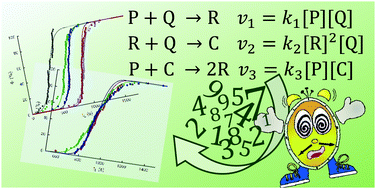Imperfect mixing as a dominant factor leading to stochastic behavior: a new system exhibiting crazy clock behavior
Abstract
It is clearly demonstrated that the arsenous acid–periodate reaction displays crazy-clock behavior when a statistically meaningful number of kinetic runs are performed under “exactly the same” conditions. Both extensive experimental and numerical simulation results gave convincing evidence that the stochastic feature of the title reaction originates from the imperfection of the mixing process, and neither local random fluctuation nor initial inhomogeneity alone is capable of explaining adequately the observed phenomena. Imperfect mixing is manifested—in practice—in the unintentional and inherent formation of dead volumes where the concentration of the reactants may even significantly differ from the ones measured in the case of a completely uniform concentration distribution, and the system may spend enough time there under imperfectly mixed conditions to complete the nonlinear chemical process. Furthermore, it is also shown that a more efficient mixing, i.e. a smaller dead volume size and shorter residence time being spent in the dead volume, does not necessarily mean Landolt times are smaller than the one measured under completely homogeneous conditions. Evidently, the “initial” concentration of the reagents in the dead volume—and of course in the rest of the solution—greatly influences the Landolt time to be measured in the case of an individual kinetic run and may therefore show either positive or negative deviation from the Landolt time for the completely homogeneous state. As a result, less efficient mixing may either accelerate or decelerate the rate of a nonlinear autocatalytic reaction at a macroscopic volume level.



 Please wait while we load your content...
Please wait while we load your content...